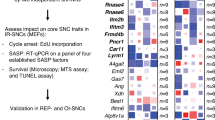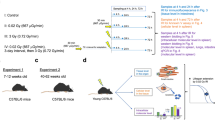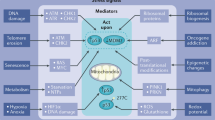Abstract
The p53 tumour suppressor is activated by numerous stressors to induce apoptosis, cell cycle arrest, or senescence. To study the biological effects of altered p53 function, we generated mice with a deletion mutation in the first six exons of the p53 gene that express a truncated RNA capable of encoding a carboxy-terminal p53 fragment. This mutation confers phenotypes consistent with activated p53 rather than inactivated p53. Mutant (p53+/m) mice exhibit enhanced resistance to spontaneous tumours compared with wild-type (p53+/+) littermates. As p53+/m mice age, they display an early onset of phenotypes associated with ageing. These include reduced longevity, osteoporosis, generalized organ atrophy and a diminished stress tolerance. A second line of transgenic mice containing a temperature-sensitive mutant allele of p53 also exhibits early ageing phenotypes. These data suggest that p53 has a role in regulating organismal ageing.
This is a preview of subscription content, access via your institution
Access options
Subscribe to this journal
Receive 51 print issues and online access
$199.00 per year
only $3.90 per issue
Buy this article
- Purchase on SpringerLink
- Instant access to full article PDF
Prices may be subject to local taxes which are calculated during checkout








Similar content being viewed by others
References
Levine, A. J. p53, the cellular gatekeeper for growth and division. Cell 88, 323–331 (1997).
Ko, L. J. & Prives, C. p53: puzzle and paradigm. Genes Dev. 10, 1054–1072 (1996).
Giaccia, A. J. & Kastan, M. B. The complexity of p53 modulation: emerging patterns from divergent signals. Genes Dev. 12, 2973–2983 (1998).
Itahana, K., Dimri, G. & Campisi, J. Regulation of cellular senescence by p53. Eur. J. Biochem. 268, 2784–2791 (2001).
Atadja, P., Wong, H., Garkavtsev, I., Geillette, C. & Riabowol, K. Increased activity of p53 in senescing fibroblasts. Proc. Natl Acad. Sci. USA 92, 8348–8352 (1995).
Bond, J. A. et al. Evidence that transciptional activation by p53 plays a direct role in the induction of cellular senescence. Oncogene 13, 2097–2104 (1996).
Webley, K. et al. Posttranslational modifications of p53 in replicative senescence overlapping but distinct from those induced by DNA damage. Mol. Cell. Biol. 20, 2803–2808 (2000).
Shay, J. W., Pereira-Smith, O. M. & Wright, W. E. A role for both RB and p53 in the regulation of human cellular senescence. Exp. Cell Res. 196, 33–39 (1991).
Bond, J. A., Wyllie, F. S. & Wynford-Thomas, D. Escape from senescence in human diploid fibroblasts induced directly by mutant p53. Oncogene 9, 1885–1889 (1994).
Gire, V. & Wynford-Thomas, D. Reinitiation of DNA synthesis and cell division in senescent human fibroblasts by microinjection of anti-p53 antibodies. Mol. Cell. Biol. 18, 1611–1621 (1998).
Serrano, M., Lin, A. W., McCurrach, M. E., Beach, D. & Lowe, S. W. Oncogenic ras provokes premature cell senescence associated with accumulation of p53 and p16INK4a. Cell 88, 593–602 (1997).
Sager, R. Senescence as a mode of tumor suppression. Environ. Health Perspect. 93, 59–62 (1991).
Campisi, J. Aging and cancer: the double-edged sword of replicative senescence. J. Am. Geriatric Soc. 45, 482–488 (1997).
Rudolph, K. L. et al. Longevity, stress response, and cancer in aging telomerase-deficient mice. Cell 96, 701–712 (1999).
Chin, L. et al. p53 deficiency rescues the adverse effects of telomere loss and cooperates with telomere dysfunction to accelerate carcinogenesis. Cell 97, 527–538 (1999).
Vogel, H., Lim, D. S., Karsenty, G., Finegold, M. & Hasty, P. Deletion of Ku86 causes early onset of senescence in mice. Proc. Natl Acad. Sci. USA 96, 10770–10775 (1999).
Lim, D. S. et al. Analysis of ku80-mutant mice and cells with deficient levels of p53. Mol. Cell. Biol. 20, 3772–3780 (2000).
Migliaccio, E. et al. The p66shc adaptor protein controls oxidative stress response and life span in mammals. Nature 402, 309–313 (1999).
Donehower, L. A. et al. Mice deficient for p53 are developmentally normal but susceptible to spontaneous tumours. Nature 356, 215–221 (1992).
Jacks, T. et al. Tumor spectrum analysis in p53-mutant mice. Curr. Biol. 4, 1–7 (1994).
Purdie, C. A. et al. Tumour incidence, spectrum and ploidy in mice with a large deletion in the p53 gene. Oncogene 9, 603–609 (1994).
Lavigueur, A. et al. High incidence of lung, bone, and lymphoid tumors in transgenic mice overexpressing mutant alleles of the p53 oncogene. Mol. Cell. Biol. 9, 3982–3991 (1989).
Arking, R. Biology of Aging 2nd edn 153–250 (Sinauer, Sunderland, Massachusetts, 1998).
Kalu, D. N. in Handbook of Physiology, Section 11: Aging (ed. Masoro, E. J.) 395–412 (Oxford Univ. Press, New York, 1995).
Weiss, A., Arbell, I., Steinhagen Thiessen, E. & Silbermann, M. Structural changes in aging bone: osteopenia in the proximal femurs of female mice. Bone 12, 165–172 (1991).
Chuttani, A. & Gilchrest, B. A. in Handbook of Physiology, Section 11: Aging (ed. Masoro, E. J.) 309–324 (Oxford Univ. Press, New York, 1995).
Harrison, D. E. & Archer, J. R. Biomarkers of aging: tissue markers. Future research needs, strategies, directions and priorities. Exp. Gerontol. 23, 309–321 (1988).
Shock, N. W. Aging of physiological systems. J. Chronic Dis. 36, 137–142 (1983).
Gerstein, A. D., Phillips, T. J., Rogers, G. S. & Gilchrest, B. A. Wound healing and aging. Dermatol. Clin. 11, 749–757 (1993).
Muravchik, S. in Clinical Anesthesia 3rd edn (eds Barash, P. G., Cullen, B. F. & Stoelting, R. K.) 1125–1136 (Lippincott-Raven, Philadelphia, 1997).
Harvey, R. C. & Paddleford, R. R. Management of geriatric patients. A common occurrence. Vet. Clin. North Am. Small Anim. Pract. 29, 683–699 (1999).
Harrison, D. E. Evaluating functional abilities of primitive hematopoietic stem cell populations. Curr. Top. Microbiol. Immunol. 177, 13–30 (1992).
Takeda, T. et al. Pathobiology of the senescence-accelerated mouse (SAM). Exp. Gerontol. 32, 117–127 (1997).
Michalovitz, D., Halevy, O. & Oren, M. Conditional inhibition of transformation and of cell proliferation by a temperature-sensitive mutant of p53. Cell 62, 671–680 (1990).
Hupp, T. R., Sparks, A. & Lane, D. P. Small peptides activate the latent sequence-specific DNA binding function of p53. Cell 83, 237–245 (1995).
Jayaraman, J. & Prives, C. Activation of p53 sequence-specific DNA binding by short single strands of DNA requires the p53 C-terminus. Cell 81, 1021–1029 (1995).
Muller-Tiemann, B. F., Halazonetis, T. D. & Elting, J. J. Identification of an additional negative regulatory region for p53 sequence-specific DNA binding. Proc. Natl Acad. Sci. USA 95, 6079–6084 (1998).
Selivanova, G. et al. Restoration of the growth suppression function of mutant p53 by a synthetic peptide derived from the p53 C-terminal domain. Nature Med. 3, 632–638 (1997).
Selivanova, G., Rybachenko, L., Jannson, E., Iotsova, V. & Wiman, K. G. Reactivation of mutant through interaction of a C-terminal preptide with the core domain. Mol. Cell. Biol. 19, 3395–3402 (1999).
Hasty, P., Ramirez-Solis, R., Krumlauf, R. & Bradley, A. Introduction of a subtle mutation into the Hox-2.6 locus in embryonic stem cells. Nature 350, 243–246 (1991).
Hogan, B., Beddington, R., Costantini, F. & Lacy, E. Manipulating the Mouse Embryo: A Laboratory Manual 2nd edn 189–216 (Cold Spring Harbor Laboratory Press, New York, 1994).
Venkatachalam, S. et al. Retention of wild-type p53 in tumors from p53 heterozygous mice: reduction of p53 dosage can promote cancer formation. EMBO J. 17, 4657–4667 (1998).
Ducy, P. et al. Increased bone formation in osteocalcin-deficient mice. Nature 382, 448–452 (1996).
Wojcik, S. M., Bundman, D. S. & Roop, D. R. Delayed wound healing in keratin 6a knockout mice. Mol. Cell. Biol. 20, 5248–5255 (2000).
Acknowledgements
We thank X.-J. Wang, G. Van Zant, D. Roop, R. Waikel, P. Biggs, M. Patel, S. Wojcik, R. Levasseur, V. Hortenstine, R. Ford, S. Wojcik, C. Pickering, R. Geske and M. Oren for advice and technical assistance. We also thank G. Lozano for luciferase and p53 plasmids. This study was supported by the National Cancer Institute.
Author information
Authors and Affiliations
Corresponding author
Rights and permissions
About this article
Cite this article
Tyner, S., Venkatachalam, S., Choi, J. et al. p53 mutant mice that display early ageing-associated phenotypes. Nature 415, 45–53 (2002). https://doi.org/10.1038/415045a
Received:
Accepted:
Issue Date:
DOI: https://doi.org/10.1038/415045a
This article is cited by
-
Progressive senescence programs induce intrinsic vulnerability to aging-related female breast cancer
Nature Communications (2024)
-
Tissue specificity and spatio-temporal dynamics of the p53 transcriptional program
Cell Death & Differentiation (2023)
-
Intracellular FGF1 protects cells from apoptosis through direct interaction with p53
Cellular and Molecular Life Sciences (2023)
-
Joint effects of phenol, chlorophenol pesticide, phthalate, and polycyclic aromatic hydrocarbon on bone mineral density: comparison of four statistical models
Environmental Science and Pollution Research (2023)
-
Aberrant activation of p53/p66Shc-mInsc axis increases asymmetric divisions and attenuates proliferation of aged mammary stem cells
Cell Death & Differentiation (2022)



